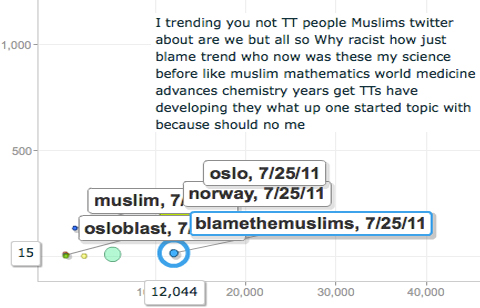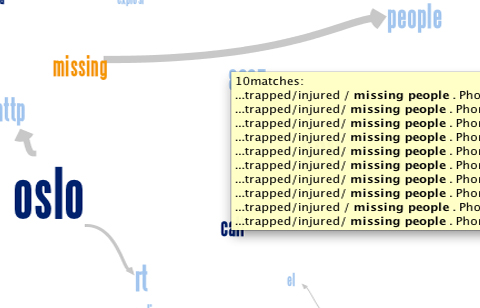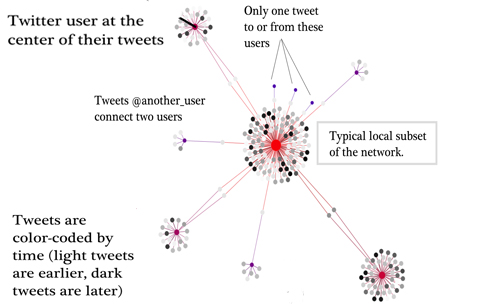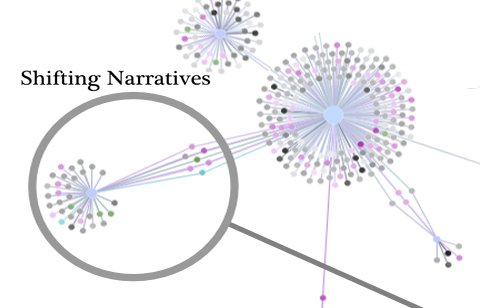As the world continues to reel from the shockwaves sent by the recent violence in Norway, we need also to grapple with the reactions that immediately followed and what they mean. An online analysis of Twitter posts carried out by R-Shief, a lab that provides real-time analysis of opinion about late-breaking issues, gives credence to what observers have been condemning as an appalling day for Western media—and which laid bare a proliferating Islamophobia.
Just as real events on the ground last week in Oslo created a global impact, so did the words, media, and proliferation of racist sentiment over the Internet. It is critical to recognize the impact of this global conversation. One piece of the puzzle relies on understanding the semantic structure of communication that occurs on the web. Similar to how researchers sift through court records, print manuscripts, and other accepted (and conventional) narratives, our method of inquiry relies on documentation and analysis of the database narratives on Twitter and other new media platforms.
We recognize this is a distinct and unorthodox approach to research and publication; however, we hope to encourage our readers to begin to imagine relationships to technology other than one of so-called “mastery” (a dominant, hetero-normative experience of relating).

Fig. 1
CLICK HERE FOR INTERACTIVE INFO GRAPH
On Friday, July 22, three hours after the attacks in Oslo, R-Shief added the hashtag #Oslo to its Twitterminer tool that stores and analyzes Twitter posts every two minutes. Over the course of the first three days after the attacks, R-Shief gathered 71,521 tweets on #oslo, and 62,895 on #norway alone, in addition to all the commentary on blogs and other websites. Fig. 1 is an interactive timeline of the number of tweets over the first three days on the hashtag #oslo, compared with new hashtags that were generated from #oslo tweets. R-Shief also includes an ability to view a word cloud of the most frequent words on each hashtag for each day, as well as the ability to drill down tweet counts, character by character into several languages—Arabic, English, French, German, Spanish, and a category for other languages.
To interact with it, click on the play button at the bottom to watch the comparison of hashtags tweeted over time. On the right side, you can click on the boxes of the hashtags you want to observe. And as you scroll, up and down that list of hashtags, you will see a word cloud of most frequent words that appeared accordingly. At the top of the graph, there are three views you can choose to view the data. The first is a scatter chart, the second is an interactive bar chart, and the third is a line graph. You can also choose, specifically, which language you might want to graph on both the x and y coordinates—those are also interactive.

Fig. 2
CLICK HERE FOR INTERACTIVE INFO GRAPH
R-Shief’s Twitternomer (the code that runs Twitterminer) then counted the other most frequently mentioned hashtags and words in its history of #oslo tweets. The new hashtags that appeared frequently were automatically added to the Twitterminer. The new hashtags that emerged were: #blamethemuslims, #blamethewest, #dontblamethemuslims—while #islam and #muslim appeared to be a frequent related hashtag that people have been adding to #oslo in their tweets.
The world is expressing a discourse online that also generates its own social reality. Breivik had already announced online that he was waging a war against anti-Zionists, “cultural Marxists” and multiculturalists. His “combat” took the form of pretending to be an investigator at a youth camp and luring children into a trap, meting out public executions for almost 2 hours. Ironically, the same religious minority that inspired Breivik’s hatred is a target, not just of a fanatic who ruthlessly assassinated nearly 100 children, but also a media establishment clique to assign erroneous blame.
For many people, these horrific events are perversely tied to the collective memory and pain for the backlash of 9/11. Even Europe has seen the rise of extreme-right populism, embodied in figures such as Geert Wilders. In the first 48 hours, media sources clamored, one after the other, to hysterically denounce Muslim extremism. Their blind (and ultimately inaccurate) assumptions in the face of a vicious attack by an anti-Muslim terrorist reflect how deeply rooted Islamophobia has become in even the mainstream discourse.

Fig. 3
Figure 3 above is a bipartite graph (or network)—meaning we are showing two types of nodes: tweets and those who post tweets, i.e. Twitter users. A user is connected to all tweets that they have sent and those that have been directed towards them (through the @username aspect of a tweet). Each cluster is an Ego Network of a particular user, that shows the tweets that they sent, any users connected to those tweets, and any tweets that those users sent. Tweets are color-coded by timing such that the earliest tweets are lighter and the darker tweets are later (relative to the dataset).
The colors are key-coordinated as follows: any tweet that contains the word “Christian” are colored yellow, tweets that mention “terror” are colored fuchsia, tweets that mention “Muslim” or “Islam” are green and tweets that mention “Muslim/Islam” AND “terror” are teal (again, light to dark based on time). The graphs represent frequency of tweets with the listed words.

Fig. 4
In Figure 4, you can see the various tweets from a Twitter user who initially is sure that the bomber is Muslim and a deserved response to Norway’s “liberal policies”. But then over time, you see can see his narrative shift. At first, these tweets are sent to particular users displaying liberal and cautionary sentiment regarding the then recent bombing. Over time, after reports indicate a Caucasian and later anti-Muslim suspect, the tweets shift in tone to theories that the shooter is somehow linked to al-Qaeda and, finally, that various Twitter users are Muslim sympathizers.
Both tabloid and mainstream media offered an antagonizing image. Several tabloids papers ran big front page headlines suggesting that al-Qaeda was responsible for the attacks. News of the perpetrator’s ethnic and political identity did not stop the highly suggestive— reaching absurd levels - speculations in the US either. The Muslim link was for instance declared “inevitable.” “Experts” clamoring for attention showed not only a lack of professionalism, but also—by speculating, rather than reporting facts—contributed to a dangerous scapegoating that will likely encourage more violence.
Even where reporters stuck to the facts, a more insidious message was seeping through: that this massacre was, if not directly attributable to Muslim perpetrators, then somehow the responsibility of a tolerant immigration policy. Suggesting the legitimacy of unease about immigration and refugees leaves unchallenged the mantra about a ‘native…resentment’ that continues to actively fan the flames of right wing parties such as the Dutch PVV, the Belgian Vlaams Belang, the French Front National, the Italian Liga Norte, the British BNP and its street thugs EDL and the US Tea Party.
Muted, throughout, was the obvious culpability of a right-wing racist hell bent on a frightening reengineering of western civilization. Given this dramatic and obvious double standard, it is downright terrifying to think about what kind gross scene would have occurred on media platforms had the perpetrator been Muslim.
The online narratives showed another discrepancy as well. Many people on online social networking sites offered a sarcastic contrast to the offline narrative. Comments include:
"Contacted all my Christian friends, REPEAT: You don`t have to distance yourselves from the Oslo attack, I don`t think you`re involved,”
"Dear blond Europeans, please come out in mass protests condemning the terrorist attack. Don`t be silent - the moderates amongst you must reject him. If you don`t, how do we know you don`t all agree?" and
“I feel just terrible for all the blond, white, Christian men who will now be treated with suspicion at airports, have their faith vilified and have laws passed against their cultural practices”
"I like being white because I don`t have to release a statement condemning it whenever some white guy kills people."

Fig. 5
Present among legitimate tweets from everyday users is a different source of commentary: the automated and semi-automated continuous broadcast of unrelated links, typically known as spam. Spam on Twitter tends to follow trending topics and is evident even after the Norway bombing, being used to raise traffic to particular sites or videos (oftentimes erroneously described). Spammers are not just automated (typically known as "bots") but also consist of everyday users trying to promote a product, cause or site. The automated types are obvious when the Twitter traffic is visualized as a graph, appearing like spiders because they sent every tweet directed at a @username. See above and below.
Twitter and Facebook comments helped channel irony, but do in fact empower part of the audience and help enable an emerging counter narrative. More importantly going forward is the need to closely examine journalistic media reporting, as well as the online social networking zeitgeist, from the first moments of a pivotal event. This analysis is a visual study of the media, but also entails a warning.
Experts, by merit or self-acclaimed, must learn to report facts, rather than mere speculation. Even those media outlets that did fully report the events presented an image of a solitary, deranged individual. In fact, the Oslo attacks (by an extreme right-wing Christian fundamentalist) are a case of demonstrating a broader discrepancy between myth and reality, between perpetrator and victim. A simple search of the latest Europol findings reveals that less than half a percent of terrorist plots in Europe are by Islamists, with an overwhelming majority caused by separatist or far-right groups.
.jpg)
Fig. 6
In addition, aside from their stunning confusion about Islam or the Middle East, few commentators have mentioned that the attacks have occurred in the very same year that people in Tunisia, Egypt, Yemen, Bahrain, Morocco, and elsewhere, shattered the nihilistic vision of terrorists by adopting the strategy and tactics of democracy. Aside from a miniscule and dwindling minority, “the Arab street” has generally moved on—while white Christian fundamentalists seem trapped in a violent past.
Many world leaders pointed at a responsibility to stand with the Norwegians and join the fight against terrorism when they too assumed it was a “Jihadi” attack. Now that the issue concerns white right-wing terror, will they stick to their promise and encourage solidarity with Muslim victims marginalized by Islamophobes? Breivik set out to violently foment a cultural purge within western societies. But it seems that he need not have resorted to violence – the mainstream media, and our popular culture (reflected through the lens of its digital voices), are already doing the job.
This article has been co-written by R-Shief Affiliates Miriyam Aouragh, Shahid Buttar, and VJ Um Amel. Data visualizations coded and designed by Elijah Meeks and VJ Um Amel.